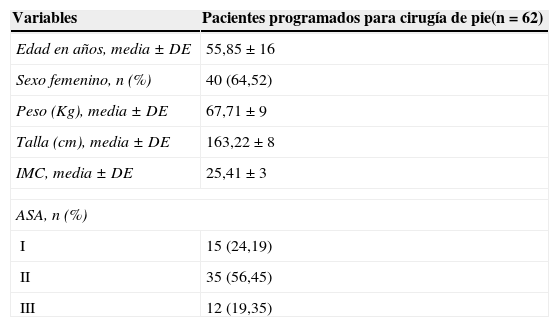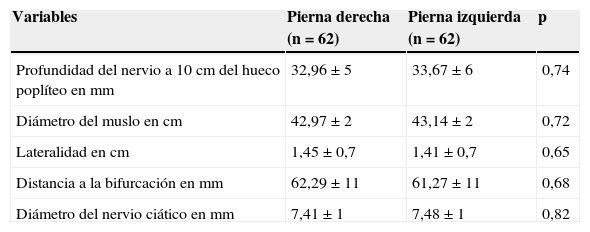Explorar si la ubicación del nervio ciático (NC) a nivel del hueco poplíteo se relaciona con variables antropométricas en la población adulta. Identificar posibles variaciones anatómicas y sus posibles implicaciones en la práctica clínica.
Material y métodoEstudio prospectivo observacional en cirugía ambulatoria programada. Se examinaron por ultrasonografía la profundidad, la lateralidad y la distancia en la que el NC se bifurca a nivel del hueco poplíteo. Se relacionaron estas mediciones según el género y otros datos antropométricos de los pacientes.
ResultadosSe incluyeron 62 pacientes, siendo 124 el total de mediciones. Existe una asociación estadísticamente significativa (p<0,001) entre la profundidad del NC y el diámetro del muslo medido a 10cm del pliegue poplíteo. La profundidad y la lateralidad promedio, medidas a 10cm del pliegue poplíteo, fueron de 3,32±0,8 y 1,43±0,9cm, respectivamente. La distancia de la bifurcación y el diámetro del nervio promedio fueron de 61,78±12 y 7,45±1,17mm, respectivamente. No hubo diferencias estadísticamente significativas entre las variables medidas y la edad/género. No se encontraron diferencias al analizar ambos miembros inferiores de cada paciente. No existe una asociación estadísticamente significativa entre la talla de los pacientes y la distancia en la que el NC se bifurca.
ConclusionesLa profundidad y lateralidad del NC son variables independientes del género, el peso y la talla. La profundidad a la que el NC se localiza a nivel del hueco poplíteo está relacionada con el diámetro del muslo. La bifurcación del NC en el hueco poplíteo no está relacionada con la talla.
To determine whether the location of the sciatic nerve (SN) at the popliteal fossa is related to anthropometric variables in the adult population, and to identify possible anatomical variations and their possible implications for clinical practice.
Materials and methodProspective observational study in elective ambulatory surgery patients. Patients were examined using ultrasound, looking at depth, laterality and distance at which the SN bifurcates at the level of the popliteal fossa. These measurements were linked to gender and the anthropometric data of the patients.
ResultsA total of 62 patients were included, with 124 measurements. A statistically significant association was found between SN depth and the diameter of the thigh measured at 10cm from the popliteal crease (P<.001). Mean depth: 3.32±0.8cm, mean laterality: 1.43±0.9cm, mean SN bifurcation distance: 61.78±12mm and mean SN diameter: 7.45±1.17mm. There were no statistical differences when comparing the measured variables with the age and gender. Similar results were obtained between measurements when comparing both lower limbs in the same patient. There was no statistical difference between height and distance at which the SN bifurcates.
ConclusionsThe depth and laterality of SN are independent of gender, weight and height. The depth at which the SN is located at the level of the popliteal fossa is related to the diameter of the thigh. The bifurcation of SN in popliteal fossa is not related to height.
Artículo
Comprando el artículo el PDF del mismo podrá ser descargado
Precio 19,34 €
Comprar ahora











